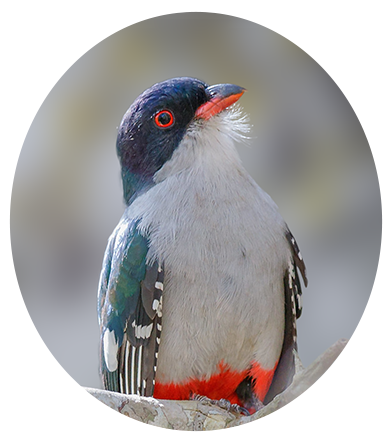

SCIENTIFIC NAME: Priotelus temnurus


The Cuban Trogon is part of the subfamily Trogoninae which includes the American trogons.

It is a medium-sized bird, measuring 9 - 9.8 inches in length and weighs 47 - 75 grams.
Adults have glossy blue-green upperparts from mantle to rump, becoming dark green towards the scalloped tail. On the upperwing, there are large white spots on coverts, and regular white notches on outer webs of primaries, but no barred wing panel like in numerous Trogonidae.
Uppertail is dark green-blue, but the central pair of rectrices shows bronze-blue inner webs. All rectrices show excised tips, giving the tail a peculiar shape. Central feathers end in ragged tips, whereas the three outer pairs of feathers have blackish base and white notches on outer webs. They protrude at the outer edge. This is especially noticeable when the tail is viewed from below.
On the underparts, the breast is grayish-white, whereas belly and undertail-coverts are red. Undertail feathers are white.
Face is blackish while crown and nape are violet-blue. Malar area, neck sides, chin and throat are white. Bill is reddish with dark gray culmen. The long tongue has split tip related to its feeding behavior. Eyes are red. Legs and feet are pinkish with black claws.
Males and females have similar plumage but the females are slightly smaller and have paler red belly.

Sings from perch, usually a branch in tree. It utters a pleasant 3-4 syllables “toco-toco-tocoro…” usually repeated for long periods, interspersed with pauses. During this song, the tail is almost trembling.
It also produces hoarse barking, various clucks, and if alarmed, a short, low mournful call nearly impossible to locate.

Feeds mainly on flowers, nectar, fruits, insects and buds, but flowers and nectar are its main food.

Common in all forested areas, including wet and dry forests and degraded former forest, shrubbery and bushes near rivers.
It usually remains in shady areas within these habitats. It also occurs in dense pine forest with tall trees.
This species can be found at all levels, but it is commoner in mountainous areas.

Very common and can be found all over the island of Cuba. The only places it is rare to see the bird is on the Isle of Youth, Guajaba, Romano, and Sabinal.

Nests in natural cavities in trees, often abandoned woodpecker’s nest, or usually a hole in decayed stump or tree trunk.
The female lays 3 - 4 white eggs with slight bluish tinge. Incubation lasts 17 - 19 days, shared by both adults.

SOURCES:
http://www.oiseaux-birds.com
https://en.wikipedia.org
Can the national bird be shipped to the us